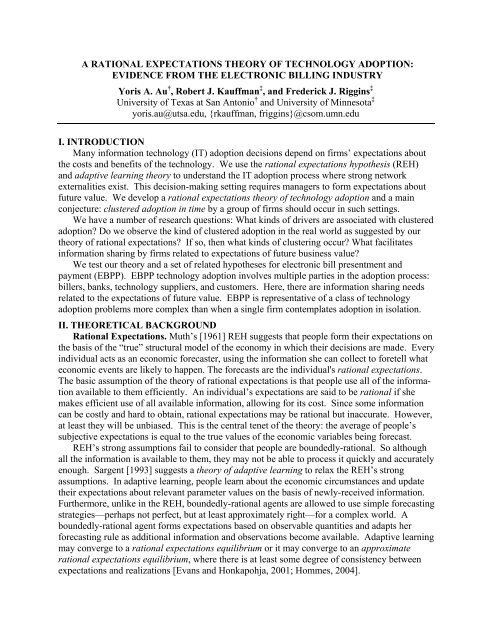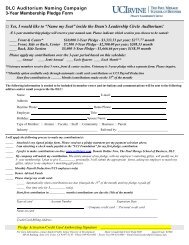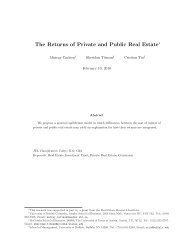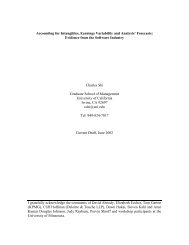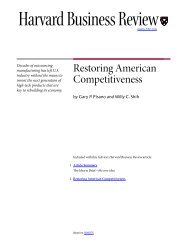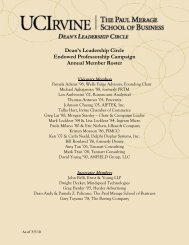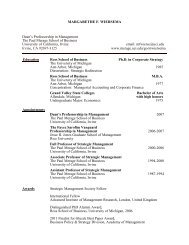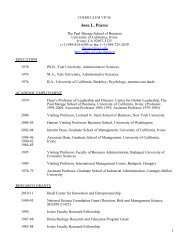A Rational Expectations Theory of Technology Adoption Evidence ...
A Rational Expectations Theory of Technology Adoption Evidence ...
A Rational Expectations Theory of Technology Adoption Evidence ...
Create successful ePaper yourself
Turn your PDF publications into a flip-book with our unique Google optimized e-Paper software.
A RATIONAL EXPECTATIONS THEORY OF TECHNOLOGY ADOPTION:<br />
EVIDENCE FROM THE ELECTRONIC BILLING INDUSTRY<br />
Yoris A. Au † , Robert J. Kauffman ‡ , and Frederick J. Riggins ‡<br />
University <strong>of</strong> Texas at San Antonio † and University <strong>of</strong> Minnesota ‡<br />
yoris.au@utsa.edu, {rkauffman, friggins}@csom.umn.edu<br />
I. INTRODUCTION<br />
Many information technology (IT) adoption decisions depend on firms’ expectations about<br />
the costs and benefits <strong>of</strong> the technology. We use the rational expectations hypothesis (REH)<br />
and adaptive learning theory to understand the IT adoption process where strong network<br />
externalities exist. This decision-making setting requires managers to form expectations about<br />
future value. We develop a rational expectations theory <strong>of</strong> technology adoption and a main<br />
conjecture: clustered adoption in time by a group <strong>of</strong> firms should occur in such settings.<br />
We have a number <strong>of</strong> research questions: What kinds <strong>of</strong> drivers are associated with clustered<br />
adoption? Do we observe the kind <strong>of</strong> clustered adoption in the real world as suggested by our<br />
theory <strong>of</strong> rational expectations? If so, then what kinds <strong>of</strong> clustering occur? What facilitates<br />
information sharing by firms related to expectations <strong>of</strong> future business value?<br />
We test our theory and a set <strong>of</strong> related hypotheses for electronic bill presentment and<br />
payment (EBPP). EBPP technology adoption involves multiple parties in the adoption process:<br />
billers, banks, technology suppliers, and customers. Here, there are information sharing needs<br />
related to the expectations <strong>of</strong> future value. EBPP is representative <strong>of</strong> a class <strong>of</strong> technology<br />
adoption problems more complex than when a single firm contemplates adoption in isolation.<br />
II. THEORETICAL BACKGROUND<br />
<strong>Rational</strong> <strong>Expectations</strong>. Muth’s [1961] REH suggests that people form their expectations on<br />
the basis <strong>of</strong> the “true” structural model <strong>of</strong> the economy in which their decisions are made. Every<br />
individual acts as an economic forecaster, using the information she can collect to foretell what<br />
economic events are likely to happen. The forecasts are the individual's rational expectations.<br />
The basic assumption <strong>of</strong> the theory <strong>of</strong> rational expectations is that people use all <strong>of</strong> the information<br />
available to them efficiently. An individual’s expectations are said to be rational if she<br />
makes efficient use <strong>of</strong> all available information, allowing for its cost. Since some information<br />
can be costly and hard to obtain, rational expectations may be rational but inaccurate. However,<br />
at least they will be unbiased. This is the central tenet <strong>of</strong> the theory: the average <strong>of</strong> people’s<br />
subjective expectations is equal to the true values <strong>of</strong> the economic variables being forecast.<br />
REH’s strong assumptions fail to consider that people are boundedly-rational. So although<br />
all the information is available to them, they may not be able to process it quickly and accurately<br />
enough. Sargent [1993] suggests a theory <strong>of</strong> adaptive learning to relax the REH’s strong<br />
assumptions. In adaptive learning, people learn about the economic circumstances and update<br />
their expectations about relevant parameter values on the basis <strong>of</strong> newly-received information.<br />
Furthermore, unlike in the REH, boundedly-rational agents are allowed to use simple forecasting<br />
strategies—perhaps not perfect, but at least approximately right—for a complex world. A<br />
boundedly-rational agent forms expectations based on observable quantities and adapts her<br />
forecasting rule as additional information and observations become available. Adaptive learning<br />
may converge to a rational expectations equilibrium or it may converge to an approximate<br />
rational expectations equilibrium, where there is at least some degree <strong>of</strong> consistency between<br />
expectations and realizations [Evans and Honkapohja, 2001; Hommes, 2004].
Sub-Groups and Willingness-to-Pay. In the IT adoption context, suppose there is a group<br />
<strong>of</strong> N potential adopting firms that wish to decide whether to adopt a new technology or to wait<br />
until another, possibly better technology becomes available. The technology exhibits strong<br />
network externalities. To realize the expectations about the benefits from network externalities,<br />
a firm in the sub-group will adopt only when it has learned that the other N – 1 firms are also<br />
ready to adopt the same technology. This is to prevent the firm from getting stranded with a<br />
technology that no other firm has chosen, such that little externality value flows. As a result, we<br />
can expect that each firm in the sub-group will adopt the technology at about the same time.<br />
Firms may initially have different levels <strong>of</strong> expectations about the value <strong>of</strong> the technology<br />
and, consequently, different levels <strong>of</strong> willingness-to-pay (WTP). WTP is the maximum price the<br />
firm will pay to purchase the technology. To achieve concurrent adoption decisions, each firm<br />
must reach a WTP level at least equal to the price set by the technology supplier. If some firms<br />
in the sub-group have a WTP below the technology supplier’s price, then all firms will defer<br />
adoption. Potential adopters freely share information with each other at no cost. Information<br />
transmission is essential for alignment <strong>of</strong> expectations which, in turn, facilitates adoption.<br />
Benchmarking, Information Sharing and Clustered <strong>Adoption</strong>. Under certain conditions,<br />
we expect to observe clustered adoption [Au and Kauffman, 2005], the adoption <strong>of</strong> a technology<br />
by multiple firms at about the same time (in a window <strong>of</strong> time). IT adoption decision-makers<br />
will observe the environment and try to align their expectations with those <strong>of</strong> other decision<br />
makers before deciding to adopt. This alignment is necessary to help shape each decisionmaker’s<br />
expectations about the value, due to uncertainty about externality value.<br />
In their effort to align their expectations, decision makers benchmark against each other and<br />
share information within a targeted group. Benchmarking refers to the process in which firms<br />
evaluate various aspects <strong>of</strong> their business processes in relation to the best practice within their<br />
own group, which consists <strong>of</strong> firms that share similar characteristics and objectives (e.g., belong<br />
in the same industry, competing in or serving the same market). In the case <strong>of</strong> the adoption<br />
process <strong>of</strong> a new technology, however, it may not be easy for firms in the sub-group to all come<br />
to the same conclusions about value, due to the uncertain value flows associated with the<br />
network externalities inherent in the new technology. Through this benchmarking process, the<br />
sub-group firms will learn from each other, by sharing information about their perceptions <strong>of</strong> the<br />
expected value <strong>of</strong> the technology. This results in time-clustered adoption in the marketplace.<br />
The information sharing that we refer to will occur in the form <strong>of</strong> informal communications<br />
through email, telephone calls, conference presentations and panel discussions, and other<br />
informal interactions. This kind <strong>of</strong> communication meets the criterion for what is typically<br />
called cheap talk [Crawford and Sobel, 1982]. Although it may seem insignificant, Kim [1996]<br />
suggests that repeated interaction among firms makes cheap talk credible, improving the<br />
efficiency in outcomes that may be infeasible otherwise.<br />
Time-clustering <strong>of</strong> adoption occur due to: geographical collocation, geographical reach,<br />
industry sector, and technology vendor. We consider the role <strong>of</strong> information transmission, and<br />
develop hypotheses on the patterns <strong>of</strong> technology adoption. Our hypotheses are:<br />
• H1 (Geographical Collocation Clustered <strong>Technology</strong> <strong>Adoption</strong> Hypothesis).<br />
Firms in a geographical region will adopt EBPP technology at about the same time,<br />
resulting in clustered adoption by geographical region.<br />
• H2 (Geographical Reach Hypothesis). Firms located within a specific state (local<br />
firms), as opposed to multiple states (regional firms), will adopt EBPP technology at<br />
about the same time, resulting in clustered adoption by geographical reach.<br />
2
• H3 (Common Industry Sector <strong>Technology</strong> <strong>Adoption</strong>). Firms serving the same<br />
industry will adopt EBPP technology at about the same time, resulting in clustered<br />
adoption by industry sector.<br />
• H4 (Competing Vendor). Firms competing with the same vendor will adopt EBPP<br />
technology at about the same time, resulting in clustered adoption grouped by vendor.<br />
• H5 (Information Transmission). More EBPP-related conferences within the region<br />
will be positively assocated with more observed clustered adoption.<br />
• H6 (Information Transmission <strong>Technology</strong> <strong>Adoption</strong> Rate). More EBPP-related<br />
conferences in a region will be positively assocated with faster rates <strong>of</strong> EBPP adoption.<br />
III. MODELS, DATA AND METHODS<br />
Models. We use a multiplicative cross-sectional (MCS) model as the primary means for<br />
testing the clustered adoption hypotheses. We also test an accelerated failure time (AFT) model,<br />
involving panel data with time-varying covariates for identifying the instantaneous likelihood <strong>of</strong><br />
adoption <strong>of</strong> a particular firm at a specific point in time. Consequently, we specify two different<br />
sets <strong>of</strong> dependent variables. DevMeanAdoptTime is used in our MCS model to represent deviation<br />
<strong>of</strong> the time-<strong>of</strong>-adoption <strong>of</strong> a firm from its group mean time-<strong>of</strong>-adoption. TimeToEvent is used in<br />
the AFT model for duration from the start <strong>of</strong> the observation period to the event. For each firm,<br />
the event is coded with a “1” if the firm made an adoption decision, and with a “0” if otherwise.<br />
The independent variables are almost the same in the two models. They include dummy<br />
variables to indicate the geographical location <strong>of</strong> each firm (Northeast, Midwest, South), geographical<br />
reach (FirmReach), EBPP vendor (Metavante), and industry (Telecom); as well as continuous<br />
variables to represent the change in the number <strong>of</strong> EBPP-related conferences between periods<br />
(∆Lag2QConfDensity), the percentage change <strong>of</strong> the quarterly average <strong>of</strong> Dow Jones Industrial<br />
Average index (∆Lag2QDJIA), and the percentage change <strong>of</strong> the quarterly average <strong>of</strong> the vendor<br />
stock prices (∆Lag2QVendorStockPrice). Some variables involve logical time lags.<br />
Data. Our sample involves EBPP-adopting firms for U.S. utilities and telecommunications,<br />
and two major EBPP vendors: CheckFree and Metavante. The data sources include the e-billing<br />
vendors for corporate customers, adoption dates from Google, LexisNexis, and annual reports <strong>of</strong><br />
each adopting firm. <strong>Adoption</strong> date is the date when a company signed an EBPP agreement with<br />
the technology vendor. Other variables include company location (city, state, and zip code),<br />
size (number <strong>of</strong> customers by year), annual sales EBIT and number <strong>of</strong> EBPP conferences by<br />
region by time. The financial data were obtained from COMPUSTAT, and the conference data<br />
were obtained from conference organizer Web sites and interviews.<br />
IV. RESULTS AND DISCUSSION<br />
MCS Results. The estimation results from our MCS model follow. (See Table 1.) We use<br />
dummy variables to represent regions (Northeast, Midwest, and South), indicating significant<br />
differences for individual sub-groups from average time-to-adopt. We expect firms in regional<br />
sub-groups will be clustered in their adoption time, and different from the overall average. The<br />
FirmReach variable (equals “1,” if a firm is a regional firm) is also statistically significant,<br />
indicating there is some clustering <strong>of</strong> regional firms. The positive coefficient suggests that<br />
operating in more than one state will tend to adopt later than the one-state (local) firms.<br />
The fact that Metavante is statistically significant suggests that there is a relative clustering <strong>of</strong><br />
Metavante-adopting firms in terms <strong>of</strong> time-<strong>of</strong>-adoption. Also ∆Lag2QConfDensity and<br />
∆Lag2QDJIA have negative coefficients and are highly significant. This suggests an increase in<br />
conference activities and a positive change in the economy accelerated EBPP adoption.<br />
3
Table 1. Results <strong>of</strong> the Multiplicative Cross-Sectional (MCS) Model for EBPP <strong>Adoption</strong><br />
VARIABLES COEF.(STD. ERR.) p-VALUE VIF<br />
Constant 4.585 (0.444) 0.000 *** 0.000<br />
Northeast 0.187 (0.093) 0.048 ** 1.733<br />
Midwest 0.186 (0.096) 0.057 * 1.620<br />
South 0.249 (0.093) 0.009 *** 1.721<br />
FirmReach 0.170 (0.074) 0.026 ** 1.241<br />
Metavante 0.208 (0.111) 0.064 * 1.223<br />
∆Lag2QConfDensity -1.143 (0.188) 0.000 *** 1.337<br />
∆Lag2QDJIA -2.163 (0.604) 0.001 *** 1.311<br />
∆Lag2QVendorStockPrice 0.088 (0.054) 0.105 1.160<br />
R 2 (Adj.-R 2 ): 0.60 (0.56) F-statistic:13.40 ***<br />
Notes. Model: Multiplicative cross-sectional (MCS). Dependent var.: ln(DevMeanToAdopt).<br />
Sample size is N = 80. Signif.: * p < .10, ** p < .05, and *** p < .01.<br />
AFT Model Results. The MCS model is the primary means for testing the clustered<br />
adoption hypotheses. We use an accelerated failure time (AFT) model for identifying the<br />
instantaneous likelihood <strong>of</strong> adoption <strong>of</strong> EBPP by firms over time. An AFT model captures the<br />
essence <strong>of</strong> the information structure <strong>of</strong> the EBPP adoption setting: increasing likelihood <strong>of</strong><br />
adoption over time due to the maturing qualities <strong>of</strong> the technology solution [Hougaard, 2000].<br />
We determined that the appropriate distributions for the underlying hazard function were the<br />
Weibull and the log-logistic distributions. Although the results are slightly different due to the<br />
different models employed, we see consistencies in some <strong>of</strong> the variables, such as FirmReach<br />
and ∆Lag2QConfDensity. (See Table 2.)<br />
Table 2. Results <strong>of</strong> the Accelerated Failure Time (AFT) Model for EBPP <strong>Adoption</strong><br />
VARIABLE COEFF. (STD. ERROR) Z (SIGNIFICANCE)<br />
Constant 2.757 (0.061) 44.98 ***<br />
Northeast 0.051 (0.055) 0.92<br />
Midwest -0.054 (0.057) -0.94<br />
South -0.002 (0.056) -0.03<br />
FirmReach 0.122 (0.046) 2.62 ***<br />
Metavante 0.003 (0.066) 0.04<br />
∆Lag2QConfDensity -0.030 (0.011) -2.64 ***<br />
∆Lag2QDJIA -0.892 (0.374) -2.38 **<br />
∆Lag2QVendorStockPrice -0.061 (0.028) -2.21 **<br />
Log-likelihood: -99.510 LR(χ 2 ): 30.89 Prob > χ 2 : 0.001 ***<br />
Notes. Model: Accelerated failure time (AFT) model. Dependent var.: Time-to-adopt (t).<br />
N = 80. Signif.: * p < .10, ** p < .05, and *** p < .01. LR(χ 2 ) is the likelihood ratio χ 2 .<br />
The AFT model variables have a similar interpretation to those in the MCS model. A positive<br />
coefficient for FirmReach suggests that regional firms adopted later than local firms. A negative<br />
coefficient for ∆Lag2QConfDensity implies that an increase in conference activities accelerates<br />
the adoption <strong>of</strong> EBPP. The results generally corroborate the MCS findings.<br />
Extensions. Our clustered adoption theory can be extended to other technologies that exhibit<br />
strong network externalities and complex information sharing-based adoption decision-making.<br />
Such technologies include RFID, Wi-Fi, and B2B procurement systems. Before making a<br />
decision to adopt, firm decision-makers should collect and utilize all available information. Each<br />
4
IT adoption involves choosing the right standards, designs, and infrastructures. Since network<br />
externalities will be involved across multiple players, we expect to see clustered adoption.<br />
V. CONCLUSION<br />
This research applies rational expectations and adaptive learning theory to technology<br />
adoption issues. This “ratex theory” allows us to examine issues in technology adoption that<br />
involve multiple parties who seek to align their expectations <strong>of</strong> value prior to making a decision<br />
to adopt. It further enables us to <strong>of</strong>fer an alternative perspective by factoring in the complex<br />
interactions among different firms over multiple periods. This view takes into account learning<br />
and information sharing that occur over many periods in the marketplace. Although the<br />
alignment <strong>of</strong> expectations by multiple firms with similar information will never be perfect due to<br />
bounded rationality and the costs associated with processing information, the theory provides a<br />
useful view <strong>of</strong> the underlying dynamics that occur relative to the time-clustered IT adoption.<br />
The resulting technology adoption theory suggests that, due to network externalities, it is in<br />
the best interest <strong>of</strong> each firm within a sub-group sharing similar characteristics and/or serving<br />
similar markets to adopt simultaneously (up to the point at which bounded rationality and<br />
information processing costs become influential). This leads to our proposal about clustered<br />
adoption, an alternative view to those based on the rational herding behavior theory <strong>of</strong><br />
Bikchandani et al. [1992, 1998]. Our theory differs in that it assumes that decision-makers are<br />
willing to collect and utilize the available information efficiently before deciding to adopt. This<br />
research contributes to the IS/IT literature by <strong>of</strong>fering a new theoretical perspective on multipartite<br />
technology adoption. Further studies in different industries and technology settings will<br />
enable us to confirm the soundness <strong>of</strong> the theory we have proposed.<br />
REFERENCES<br />
Au, Y. A., R. J. Kauffman. 2005. <strong>Rational</strong> expectations, optimal control and information<br />
technology. Information Systems and e-Business Mgmt. 3(1) 47-70.<br />
Bikchandani, S., D. Hirshleifer, I. Welch. 1992. A theory <strong>of</strong> fads, fashion, custom, and cultural<br />
change as informational cascades. J. Pol. Econ. 100(5) 992-1026.<br />
Bikchandani, S., D. Hirshleifer, I. Welch. 1998. Learning from the behavior <strong>of</strong> others:<br />
Conformity, fads and informational cascades. J. Econ. Persp. 12(3) 151-170.<br />
Crawford, V. P., J. Sobel. 1982. Strategic information transmission. Econometrica 50(6) 1431-<br />
1451.<br />
Evans, G. W., S. Honkapohja. 2001. Learning and <strong>Expectations</strong> in Macroeconomics. Princeton<br />
University Press, Princeton, NJ.<br />
Hommes, C. 2004. Economic system dynamics. Scott A., ed. Encyclopedia <strong>of</strong> Nonlinear Science.<br />
Routledge, Oxford, UK.<br />
Hougaard, P. 2000. Analysis <strong>of</strong> Multivariate Survival Data. Springer-Verlag, New York, NY.<br />
Kim, J. 1996. Cheap talk and reputation in repeated pretrial negotiation. RAND J. Econ. 27(4)<br />
787-802.<br />
Muth, J. F. 1961. <strong>Rational</strong> expectations and the theory <strong>of</strong> price movements. Econometrica 29(3)<br />
315-335.<br />
Sargent, T. J. 1993. Bounded <strong>Rational</strong>ity in Macroeconomics. Oxford U. Press, Oxford, UK.<br />
5


